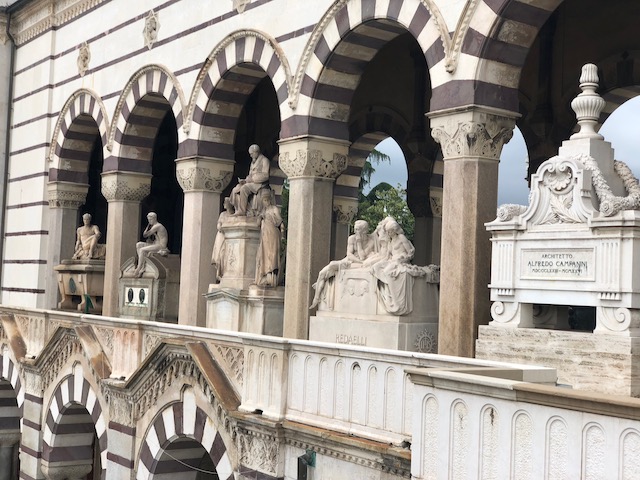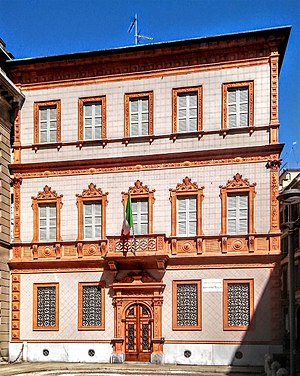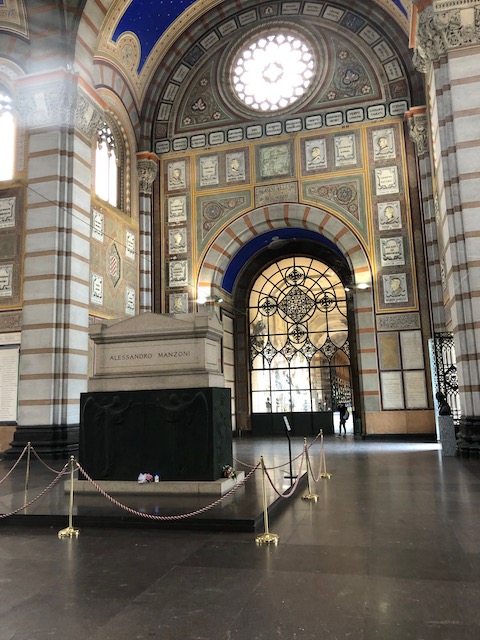During last spring’s Milan visit, Sandra Kitt and I had an afternoon at the city’s Cimitero Monumentale. This impressive urban space is one of the city’s two largest cemeteries (the other being the Cimitero Maggiore), and both were created to provide an alternative to the many small cemeteries located throughout the city.
Designed by the architect Carlo Maciachini, the Cimitero Monumentale is the smaller of the two, but it was built first, opening in 1866. It measures 300,000 sq. yds. (to the Cimitero Maggiore’s nearly 2.5 million sq. yds.). We did not attempt to visit the latter. Its size would have made a casual visit impossible, and besides, with Cimitero Monumentale’s many and much-talked about architecture and “eclectic” sculptures, it definitely appealed to us.
And “eclectic” is defiitely an appropriate descriptor for Milan’s more well-known cemetery. One description notes that the architectural style of Cimitero Monumentale is “stunning,” achieved from “a perfect meld of sumptuous Byzantine, Gothic and Romanic traces, together with delicate color contrast obtained by the combination of pure white and greenish-grey marbles.”
This last reference, to the architectural style of the cemetery’s main buildings, relates to what is now called “Lombard Romanesque” (or “First Romanesque”), a style I learned about when visiting Milan’s Basilica of Sant’Ambrogio. Marked with distinctive two colors (contrasting brick and marble, for example, at the Basilica), it became a typical Milanese architectural/construction style, adapting from the classic Romanesque.

Here, in the 19th-century main buildings of the Cimitero Monumentale, the style has been even further re-adapted, making a dramatic impression in this view of part of the main entrance to the cemetery. With the addition of the funerary statuary, the style without a doubt contributes to the overall characterization of this ornate burial ground as “eclectic.”
As it happened, the design and development of Cimitero Monumental came at a time when much change was taking place in the cultural life of all Europe. Not only were business and construction methods being done differently, societal efforts were being re-framed and moving away from what had come before. Art, architecture, and literature were all moving into new – and sometimes undiscovered – territory, as were the performing arts. For 21st century readers, we find ourselves fascinated in exploring what was happening, and specific examples are often written about. For me, a remarkable case-in-point is the recent book by Orlando Figes (The Europeans: Three Lives and the Making of a Cosmopolitan Culture). Figes paints a picture of life in the 19th century in Europe (as noted in one review) as “a time of unprecedented artistic achievement, the first age of cultural globalization―an epoch when mass communications and high-speed rail travel brought Europe together, overcoming the barriers of nationalism and facilitating the development of a truly European canon of artistic, musical, and literary works.”
How we might think about relating ourselves to the changes of 150 years ago began to fall in place when Sandi and I were visiting the Cimitero Monumentale. But I was also thinking about some of what would be coming up in my own cultural life upon my return to New York. One particularly attractive event – already announced – is to be several performances of Verdi’s Manzoni Requiem at New York’s Metropolitan Opera, and I’m very much looking forward to that program. And with the visit to Milan’s Cimitero Monumentale, I found another connection, what might be called a “historical” connection to what we were experiencing, a link that I might not have thought about before.

It had to do with Verdi’s composing the requiem in honor of Alessandro Manzoni (1785–1873), one of Milan’s most illustrious citizens. Just how illustrious was he? For one thing, he was a renowned poet, novelist and philosopher, and his name seems to be everywhere in Milan, including the street name of one of the main thoroughfares. His house (shown here) can be visited, and remains a popular attraction. And his fame did not rest only on his writing, although his 1877 novel The Betrothed (I promessi sposi) is often recognized as a symbol of the Italian Risorgimento.

The book’s patriotic message made it extremely popular, but it also became recognized as a milestone in the development of the modern Italian language. And surprisingly, Manzoni was influential in the growth and development of what has become known as “liberal Catholicism.” At Cimitero Monumental, Manzoni’s sarcophagus sits in the most prominent place in the cemetery, at the center of the main hall of the entrance building. And, interestingly, with his death just seven years after the opening of the cemetery, his must have been one of the first “celebrity” burials.
And as for that “historical connection,” I mentioned, it has been captured in print. In the September 2023 issue of Opera News. In an article called “Immortal Art,” Philip Kennicott writes about Verdi and the composition of the Manzoni Requiem.
In the article, Kennicott offers the opinion (which I for one would not contest) about how the great composer was working to bring “order and meaning to the operatic landscape.” Like many others experimenting with those societal changes described earlier, Verdi, too, in the musical realm, chose to approach his subject within a framework that turned out to be both sacred and secular. Or as Kennicott puts it when he writes about other composers moving in this direction: Verdi’s Requiem emerged “during a century of what might be called an arms race of dramatic expression within the musical language of the requiem.”
And Kennicott’s first example is a knock out: When Cherubini added a Chinese gong [in his Requiem of 1816], Kennicott writes, “the shock must have been tempered by years of convergence between music considered sacred and music considered secular.”
Other references to composers doing much the same thing makes for very satisfying reading, and of course today’s listeners have come to accept these challenges. But can’t we wonder how listeners must have reacted – in the 19th century – to this “convergence” between the sacred and the secular? Wouldn’t you have loved to have been there to see the looks on the faces of listeners when they heard (as Kennicott described) the “giant, quasi-military-scaled musical forms of Berlioz’s Requiem, including four offstage bands, in 1837”?
And Kennicott offered an even more stimulating example in describing Brahms’s German Requiem, written between 1857 and 1869, noting that Brahm’s glorious work furthered a trend that Verdi would capitalize on as well – the expansion of the requiem to serve a larger public agenda:
Verdi used the Latin text, Kennicott wrote, but his work might equally well be called an Italian Requiem, its ostensible purpose [being] to honor the great writer of the Risorgimento, Alessandro Manzoni, and its larger purpose to create a grand-scaled commemorative work in honor of the newly unified Italy.
It all comes together, bringing us back to what Sandi and I observed about the Cimitero Monumentale and – just as important – about the 19th century’s societal changes, with a completely relevant final point from Kennicott:
This was an age of monuments and memorials, and very newly minted nations wanted works of public veneration and remembrance – real and invented.
We are not surprised – we listeners in our opera houses and concert halls of the 21st century and we visitors who stroll the grounds and view the gravestones and mausoleums of a place such as the Cimitero Monumentale – when we get a good glimpse of what came before.
And yes, we can recognize and easily agree with Kennicott’s good story when he tells us that, “in 1874, when the Manzoni Requiem had its premiere in Milan’s San Marco church, the form and the subtext of the event meant different things to different people.”
So it does so today, and we are grateful for the convergence, for both the music considered sacred and the music considered secular. It now brings us much joy, no matter how we listen to it. And, not to put too fine a point on it, what we observe and take away from our visits – whether taking us back into the 19th century, perhaps, or keeping us in our own days – gives us more to appreciate about Milan’s Cimitero Monumentale.
When we think about how these cultural changes, together with different and dramatic changes in societal influences that addressed (or in some cases didn’t address) people’s needs, it becomes clear that the beauty of Milan Cimitero Monumentale was perfectly “of its time.”
To view Sandi and Guy’s photographs, click here: Milan-2023-Cimitero-Monumentale
Leave a Reply